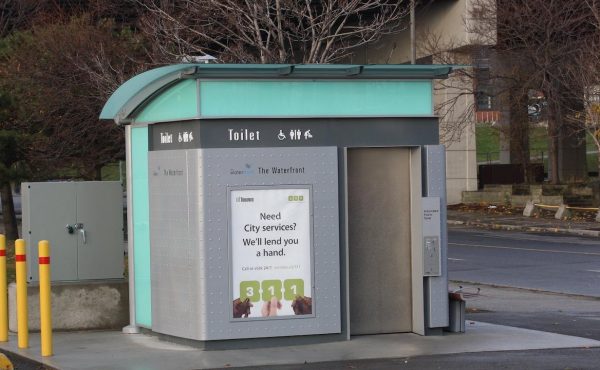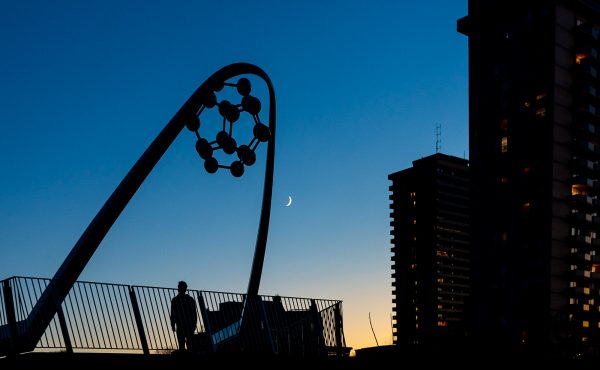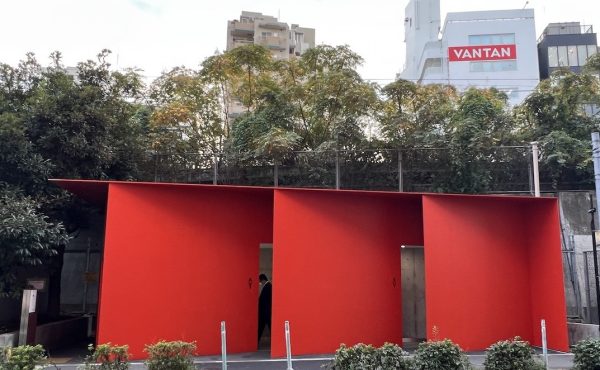• Park’s washrooms ‘closed for season’ for 2 years [ Toronto Star ]
• York cuts back on Durham incinerator commitments [ Toronto Star ]
• Luminato bis success, organizers say [ Toronto Star ]
• He’s a wheel hero [ Toronto Sun ]
• Better TTC service or ‘smart card’? [ Toronto Star ]
• Feds, Ont. should study risk of tritium, Greenpeace says [ cbc ]
• Peace Garden pavilion may survive redesign [ National Post ]
• Port authority listing [ Globe and Mail ]
• Airport here to stay, Port says [ National Post ]
photo by Andrew Wallace/Toronto Star





22 comments
Before anyone starts freaking out about ‘tritium’ in drinking water, it should be noted that tritium IS water. Don’t let Spiderman 2 fool you, tritium is just water whose hydrogen atoms have a couple extra protons (the hydrogen atoms are the tritium, but in this case, they’re found in water form)
It’s virtually harmless. Pure tritium is used all over the world in emergency exit signs since the water emits a faint glow without external power. However North America seems to suffer from a comic book fueled fear of nuclear power. We’d rather use coal and oil power plants for fear of super villains running around town in spandex tights.
Even pure tritium can’t penetrate human skin. Over time, rubbing yourself naked with copious amounts might give you something akin to a mild sunburn (but not -nearly- as harmful as sunburn). Of course this is ridiculous since it’s impossible to find tritium in such large quantities.
Ingesting is a different story. Pure tritium is harmful if swallowed. When your body is bombarded by beta radiation from the inside out, it’s not really a good thing. However, the levels we’re talking about here are very very very low. We get exposed to FAR more dangerous radiation in far far higher quantities with no ill effects.
Once again, the Globe has broken your link to its story with a demand for money.
Of course when I’m referring to Tritium above, I’m talking about tritiated water. The gas form of Tritium is about as harmless as grape jelly.
Ryan, you sound like one of those in-school “science” films (hosted by Troy McClure) from the Simpsons.
The Globe and Mail’s paywall for its columnists, such as John Barber (who is linked a lot in the day’s headlines) is particuarly annoying, I agree. The “Bug me Not” does not work for the paywall.
But there are ways around it if you have patience. If you have a Toronto library card (or one for most Ontario municipal libraries and practically any university or college as well), you can access the Globe and Mail’s articles online (usually with one day’s delay) by doing a simple search on the TPL’s website. Google News used to work great, but Bell Globemedia plugged that hole in the paywall.
The “smart card”, or more accurately, a “declining balance” card, would actually be a money-making endeavor for the TTC, not an expense.
Simply, New York’s MTA makes tens of millions every year in unclaimed, stored money, and there is no reason to believe the TTC wouldn’t reap the same benefits.
If people visit Toronto, put $10 on their smart card and only use $8 before they go back to Vancouver, for example, the TTC has actually made $2.
Additionally, the TTC claims it loses 1% of its annual revenue to fraud, and personally I believe this is a gross underestimation. Fraud would be almost eliminated with the introduction of smart cards; there is no room for underpaid or unpaid fares when the fare collection system is automated.
Smart cards make sense.
Kevin, do you have any hard figures/sources on the NYMTA smartcard revenue or is that speculation? I’d never considered that opportunity but it sounds interesting.
I think the biggest barrier for the TTC is the capital costs involved. As I understand it, the province isn’t interested in contributing and the TTC doesn’t feel that spending a quarter of a billion dollars on the technology is a priority for riders.
The Globe’s policy is asinine and shortsighted. People should cancel their subscriptions, and Spacing should not reference anything not open to the public to read. It’s not like The Globe isn’t able to make money by advertising.
Adam >> You’re bang on. The amount of money to implement it outweighs the need for it at the moment. The loss of revenue is much easier to for the TTC to absorb than installing a $150-million system. It certainly a needed service, I understand, but you can buy 75 or 100 new buses with that kind of money. The current system is not ideal but it has worked long enough that the TTC can put it off for a few years (hopefully those few yuears will result in a better funding for the transit system).
The biggest winners in all of this would be the banks and credit card companies, who are part of the heavies lobbying city hall. Imagine the fees that can be generated by allowing riders to pay with Interac of credit card?
Re: MetroCard figures:
“NYC: The MetroCard electronic payment system saved an estimated $70 million per year in fare evasion, resulting in increased revenues of $34 million from merchant fees and revenue float, $140 million per year from unused value on the cards, and $49 million from increased ridership.”
According to the Federal Transit Administration, November 1995.
Source
I assume the numbers have substantially increased since the MetroCard’s introduction and subsequent ubiquity.
It all depends. If implemented and administered sensibly a smart card system should enhance efficiency. If not, it could be a boondoggle – especially when bureaucracy is involved.
God knows where Councillor Giambrone is getting his figures. It’s surprising to see his negativity towards the idea.
Not to mention a smart card would also speed up with system with people not needing to find change or take ages entering and exiting streetcars and buses.
One of the reasons the province is pushing the SmartCard is that GO’s paper ticketing system is antiquated, and will not allow the addition of new fare zones (based on simple two-digit zone numbers). GO is running out of parts, and nobody supports their system anymore. So this is seen as something “sexy” that politicans can get behind, even though we have seen no details of any fare integration (will we be able to get any deals when crossing municipal lines? can we connect to GO Transit without paying a full TTC fare? can the card automatically decide the best fare plan based on usage and save us money?).
The suburban local bus systems have electronic fare boxes that count coinage and display to the driver tickets fed into the machine. This technology is also older and will eventually need to be replaced. Burlington and Hamilton both have a very rudimentary smartcard system (Combocard) that is also in great need of replacement.
The TTC’s fare system, except the simple magnetic stripes for weekly and Metropasses, is so old, there’s no technology involved, so the TTC doesn’t have the need to upgrade as GO and the suburban systems do. This is part of the reason why the TTC has not been enthusiastic about the smartcard idea.
A lot of this money is going to the expense accounts to Accenture, the consultants developing whatever card scheme we will get. Accenture, of course, is a rebranding of the old tainted Arthur Andersen firm.
The Province should pay in full for the smart card system. I don’t think the TTC and GO care about each other and it seems like they never work or talk together. There is virtually no integration between the TTC and GO, no easy and clear access between the two systems. For example, Exhibition Station could be a major west transit hub for GO and TTC, but the streetcars and buses don’t even drop people near the station, you still have to walk a long way to go from a TTC bus/streetcar stop to the GO exhibition station, the same thing happens at Mimico (from my experience). It might be better for many people to use GO to get downtown inside Toronto, but since the fares are much more expensive and a TTC pass is not valid when taking the GO then a trip that would take 7 minutes by train from Dundas/Bloor turns into a 20 minute trip by TTC and again you still have to walk a long way to transfer from Dundas West subway station to the Bloor Go station, there is no connectivity. I find the lack of dialogue and cooperation between the transit systems to be a much higher concern than some fancy smart cards.
The TTC doesn’t actually make a profit when I buy a $10 card and only use $8. The trains will still run whether i use the card or not.
One of the reasons the TTC has lost(my) money is due to the fact I prefer to ride my bike. If more streetcars moved faster and had more frequent service, I’d consider TTCing it.
I’d be disappointed in the TTC spent this money on a smart card system when we have real pressing needs. I like smart cards, but as mentioned above, you can buy lots of buses with that money, which is *really* what we need.
First off, the GTTA has to be doing the co-ordination. While Kevin’s numbers are convincing, what Toronto and the GTA lack (and what the NYC system has) is a properly integrated system. Once a proper plan is in place to have TTC, GO, VIVA, etc all intertwined then we can begin this process of smart cards (or it becomes part of that same process).
If the TTC was flush with cash (or just paying it 55% share like every other major city transit system) than I’d be all over this. But with our system in dire straights, we need to dedicate cash to the appropriate places.
Pay wall or no pay wall, I see no particular reason to link to John Barber’s continuing obsession on the subject of the waterfront and the Toronto Port Authority. Anyone who doesn’t know Mr. Barber’s position by now hasn’t paid attention.
His “obession” has to do with the fact that the TPA still exists or is exerting much more control over our waterfront than it should (for the moment we’ll even ignore the fact that the feds control this space when its no longer necessary). Almost all local politicians, in all 3 levels of government, agree with Barber’s sentiments and the large majority of the poeple who are affected by the waterfront’s development support this. Look no further than the election results from the last 4 years if you want specific numbers of support.
To direct this specifically at Mr Spragge, why should Spacing approve your comments that are always in support of the island airport when everyone who reads these comments regularly knows exactly where you stand on this issue?
Linking to Barber’s rants and approving your comments are *both* essential — we’re having a debate and the issues haven’t even come close to a resolution.
How about this:
Smart cards that work in other cities’ systems too, by way of reciprocal agreements or whatever. So you could take TTC to Pearson or Union Station (on new LRT, of course), zip off to Rome or Seattle or wherever and then use your smart card on your destination city’s transit system.
Sexy or what? Meanwhile, back on earth….
> I’d be disappointed in the TTC spent this money on a smart card system when we have real pressing needs.
Smart cards are an investment that will show real financial return. I am not sure why it is never presented as such, but smart cards will make money for the TTC and other transit agencies that sign on to it. That money, in turn, can be used to improve service.
Also, is including GO even on the table? Smart cards are generally intended for fixed-fare rapid transit systems like the various city buses in the GTA, not zone-based commuter services like GO.
Well said, Miles.
“Also, is including GO even on the table? Smart cards are generally intended for fixed-fare rapid transit systems like the various city buses in the GTA, not zone-based commuter services like GO.”
As I said, GO is the one that’s pushing the Smart Card the most. The first phase of the rollout will be on the Milton Line, with some Mississauga buses that serve the stations getting the card readers too. The machines are already partly in place at TTC Union Station – the TTC right now may only participate where the suburban systems feed into the subway – Union, Finch, Islington/Kipling, etc.